HP Stream 7 Review: A $119 Windows Tablet
by Brandon Chester on December 19, 2014 8:00 AM ESTCPU Performance
Inside the Stream 7 we have Intel's Atom Z3735G, which is a quad core Bay Trail part that has a base frequency of 1.33GHz and a burst frequency of 1.83GHz. It's paired with 1GB of DDR3L-RS-1333 memory, where the RS stands for "Reduced Standby". As the name implies, it has a focus on improving standby battery life on devices like tablets. Z3735G unfortunately has one of the slower memory interfaces of the Bay Trail lineup, with only single channel support and a max memory bandwidth of 5.3Gbps. Nonetheless, the CPU itself is fairly powerful, especially for a $119 device.
Although the Stream 7 does run a full copy of Windows, I've decided to run it through our mobile workflows rather than our desktop/laptop ones because I believe most users are going to use it similarly to how they use other tablets. I will elaborate on this point later in the software section, but the main point is that the normal Windows desktop experience is just not very good on touchscreens, especially 7" 1280x800 displays. Because of this, it's better to run it through benchmarks where it can be compared to other tablets. The fact that PCMark requires more space than the Stream 7 physically has is also an issue.
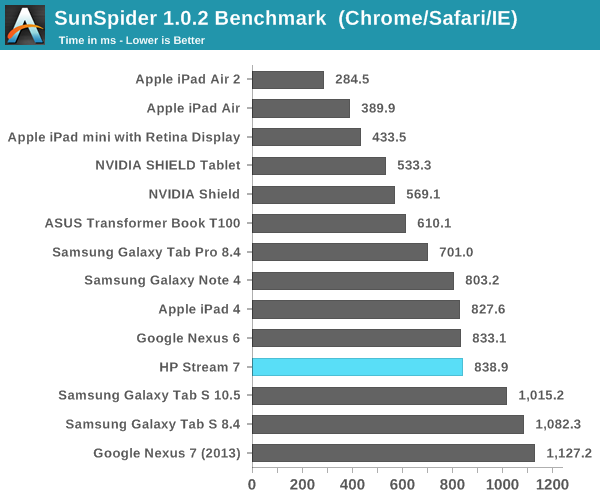

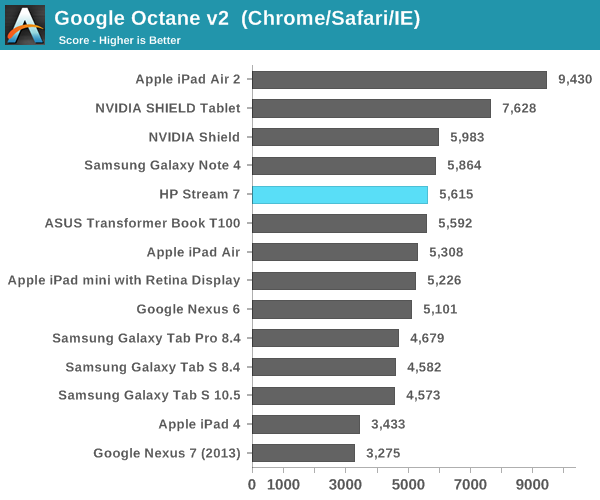
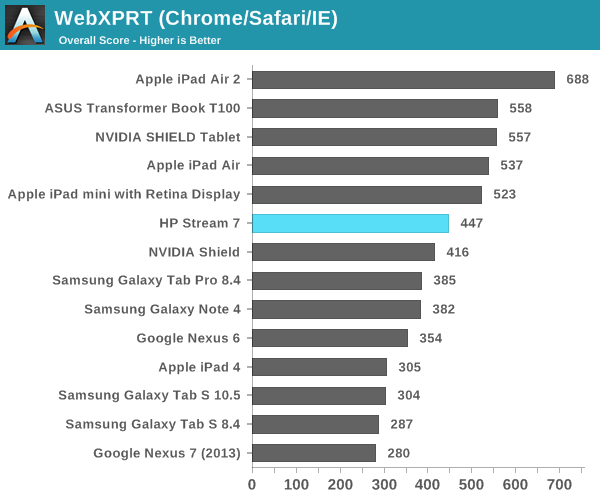
As you can see, Intel's latest Atom platform performs very well in our tests. It should be noted that these tests were performed using Chrome rather than IE, to maintain consistency with the results from previous Windows tablet reviews. This means that the Sunspider score leaves much to be desired, as Google has stopped focusing on it as an optimization target. Looking at our other tests, we see that the Stream 7 is not the fastest tablet, but it is still very fast. In fact, it's competitive with the silicon inside tablets that cost two or even three times as much, which is impressive.
GPU Performance
The Intel HD Graphics chip in Bay Trail is architecturally similar to Intel's HD 4000 graphics on Ivy Bridge. It's simply a cut down implementation with 4 EUs instead of the 16 in an Ivy Bridge chip. The implementation in Atom Z3735G scales from 311MHz to 646MHz as needed. Thankfully, the Windows Store has up-to-date versions of 3DMark and GFXBench available, so we can compare the Stream 7 to the other devices that we've benchmarked in the past.
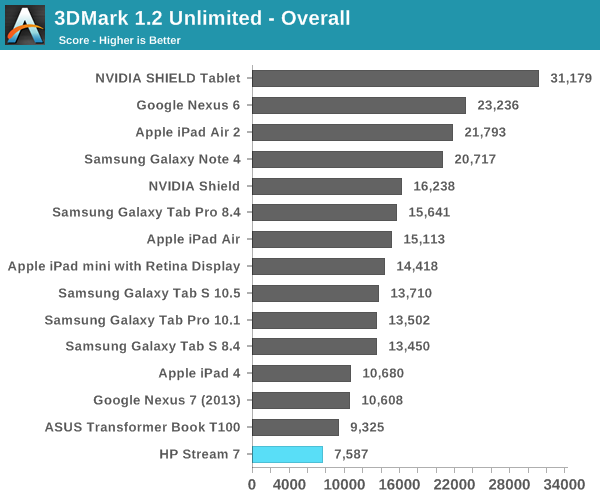
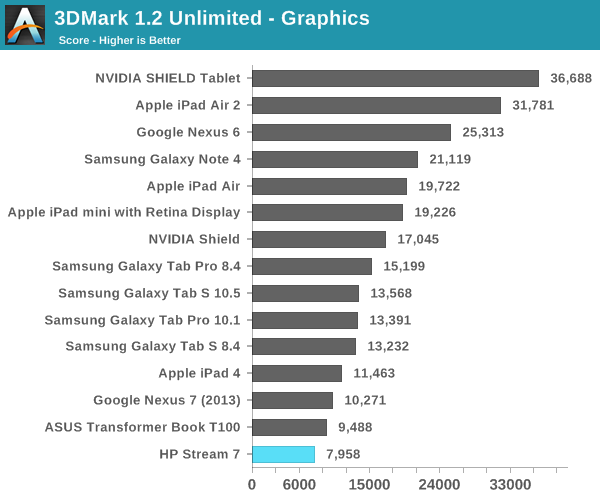
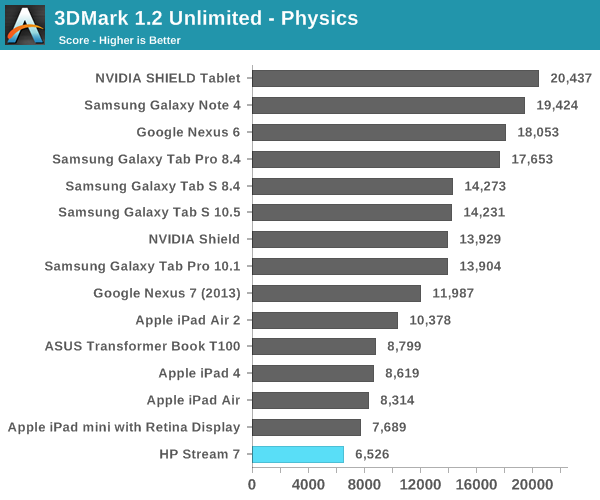
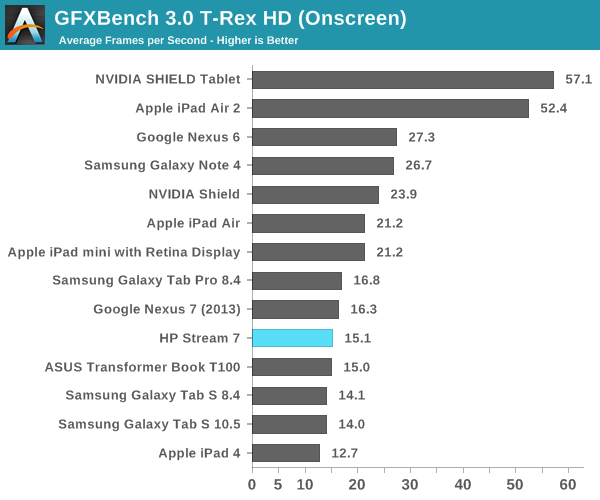
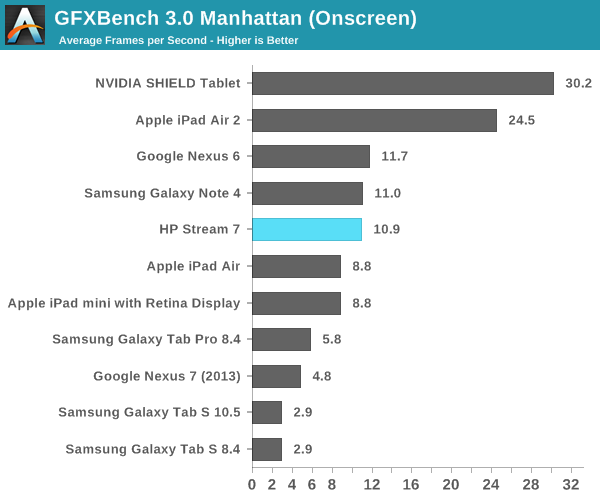


As you can see, Bay Trail isn't exactly a graphics powerhouse. However, the Stream 7's resolution means that the onscreen results aren't that bad, so you'll be able to get away with running some of the lighter games that you can on other platforms, provided of course that they're available on the Windows Store.










157 Comments
View All Comments
rootheday3 - Saturday, December 20, 2014 - link
Brandon-You say on the Display page of the review:
"It should be noted that these measurements were achieved by disabling Intel's Display Power Saving Technology (DPST) feature, which causes dynamic brightness and contrast depending on the image displayed on the screen. While some other devices do this to some degree, DPST ended up reducing max brightness measurements by nearly 100nits, and the constantly changing brightness played havoc with measurements during analysis and calibration."
and also on the battery life page:
"It's likely that enabling Intel's DPST will improve these results, but all that really means is that dimming the display below our 200nits standard will improve battery life."
DPST shouldn't reduce overall brightness - the algorithm it uses is designed to detect dark scenes and change the panel gamma curve to let more light through while reducing the backlight intensity to match. If working properly this can save a lot of backlight power on scenes that have low luminance values and moderate contrast to start with (e.g. movie watching). Normally there should be no noticeable difference in overall brightness of the image (though there may be a second or two of visible modulation if the image suddenly changes from bright to dark or vice versa). If you are seeing drops of 100 or 200 nits brightness when DPST is active, something isn't right.
For what its worth, other devices use techniques (called CABC - content adaptive backlight control) that do the same things as DPST - they generally just don't give you control over it the way that Intel's control panel does.
Are you 100% confident that the visual issues and brightness issues you are describing are isolated to this device or to Intel DPST in general and that other mobile devices don't have similar dimming going on?
Any possibility thaty you are conflating DPST vs Automatic Display Brightness (ADB) based on ambient light sensor detected brightness variations in the room?
Backlight is a huge contributor to platform power in tablets and other very low power mobile devices -If you only disable DPST on Intel platforms but don't disable CABC on other platforms, your low battery life results are perhaps not fair...
Note also that the Intel control panel offers an aggressiveness slider for DPST - can you reduce the aggressiveness value and see if that makes it better visually?
Brandon Chester - Saturday, December 20, 2014 - link
Some other devices do it in the video test, but not in the web browsing test. You can see the brightness of the Stream 7 decrease when you load a very white web page, and it goes back up when you return to somewhere like the Start Screen. This doesn't happen on an iPad. You can see in our Asus UX21 review that DPST does reduce the brightness when showing an all white screen, so I don't think there's anything wrong with my statement that DPST was reducing max brightness in our test.Oh and no, it wasn't ADB, I disabled that right when I set up the tablet.
Laststop311 - Saturday, December 20, 2014 - link
Smaller battery than note 4 phone thats only 5.7" is worriesome. This tablet could of been really good if they just upped the ram to 3GB and upped the battery to 4000+mah. I think it would of sold more if they raised the price an extr 25 for the extra 2GB of ram and an extra 15 for the extra 1000mah of battery. Doesn;t a tablet like that for 159 sound a lot better than the current one for 119Laststop311 - Saturday, December 20, 2014 - link
Wouldn't mind seeing a 64GB option for 30-50 more as wellados_cz - Sunday, December 21, 2014 - link
They can't up the ram without changing the CPU which in turn would increase the price further more, the atom Z3735G is limited to maximum of 1GB of ram. But the ram is not problem on this device, I hard-set swap file to 2GB on my Linx 7 (same atom) and it runs just great.Roy2001 - Saturday, December 20, 2014 - link
I have stream 8, Intel Soc performs very well, but OS is not so good.andrewaggb - Sunday, December 21, 2014 - link
I have a 64gb miix 2 8" windows tablet. Picked it up used/cheap. It's pretty decent, but the quantity of windows updates are a bit ridiculous. The app selection is much different, but there's plenty of games and apps my kids like on it. My daughter probably prefers it to the ipad, my son definitely prefers the ipad.Desktop apps suck on it, they run fine, but the screen is too small in my opinion.
Performance wise I think it runs fine.
Battery life is ok, but not as good as an ipad.
I imagine the stream 7 is very similar. For $100 it's probably a great deal. You also get full flash support, which I use for some streaming applications.
spdfreak - Sunday, December 21, 2014 - link
I wonder if these are basically the same as the Winbook Tablets that MicroCenter sells. The MC 7in tablet is 60.00 in today's ad. The 8in with 2GB Ram is 140.00.HD IPS LCD 7" 1280x800 Display
Intel BayTrail-T Z3735G 1.33GHz Quad-Core CPU
1GB RAM & 16 Flash Storage
Windows 8.1 OS
Expandable up to 64GB via microSD Card
The WinBook 7" TW700 Tablet has 16GB of integrated storage, which can be expanded via microSD Card. Includes 1 year subscription for Office 365 Personal.
darkich - Sunday, December 21, 2014 - link
Good review, and I agree that spec wise this is probably the best tablet for the price.But I would rather recommend buying an used Android tablet for this price.
For 110$ I got an aluminum 8“ IPS (excellent Samsung panel) 800p quad core 3G tablet with 2+5Mpix cameras, even radio, GSM and GPS. Slim, stylish and just 340g of weight. Still 20 months of warranty and in pristine condition.
Finally, for a tablet use case Android is definitely a much better choice than Windows.
jkauff - Sunday, December 21, 2014 - link
For less than a hundred bucks I can play movies on a handheld device using MPC-HC and madVR on default settings. Pretty cool. BTW, I fixed my headphone jack with a shot of compressed air and a bit of contact cleaner. It wasn't defective, just dirty.